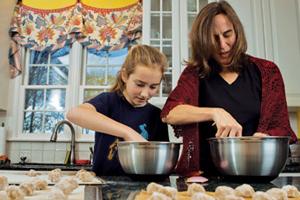A Pilot and a Parent
By Katherine Jamieson
 Maggie Yarlott Brown '81 with her daughter
|
Maggie Yarlott Brown expected a top-notch assignment when, in 1984, she became the first woman to “earn her wings”— become a U.S. Naval aviator—by going through the exact same training as male pilots. In contrast to women before her, she learned to fly tactical jets rather than slower, less maneuverable planes typically not used in combat. “I came from this mentality that I’m as good as these guys and I should be able to do this,” she says. “I had to realize that not everyone saw the world this way.”
At the time, federal law kept women out of combat assignments, preventing Brown—whom the magazine featured in 1989, along with pilot Sally de Gozzaldi ’84—from getting the experience she needed to become a test pilot. During her nine years in the U.S. Navy, she flew as an “adversary” in combat simulations to provide an opponent for the men in the fleet. In the end, she decided not to make a career of it. “I’d seen women ahead of me who’d had a difficult time and become bitter, and I didn’t want to be.”
She took a job flying with FedEx. Even with rigorous night shifts, she found the work exhilarating and flew until she was six months pregnant with her first child. Intending to return three months after the birth, she decided that she couldn’t face the reality of a four-day-a-week flying schedule with a nursing child at home. “I wanted to have children to be their mother,” she says. “It seemed like I would be just giving birth and handing him off to someone else.”
She and her husband eventually decided to homeschool, and Brown is now the lead teacher for their four children. Still qualified to fly, she says she would consider getting back into the air, perhaps as a corporate pilot. In 1992, two years after she left the Navy, the Defense Authorization Act repealed the combat exclusion law for Navy and Air Force pilots. Brown says she’s proud that she paved the way for female pilots to be taken seriously. “In some ways I wish I was 21 and able to do it again. A lot of them don’t realize how hard it used to be, and that’s a good thing.”
Photo by Rob Mattson